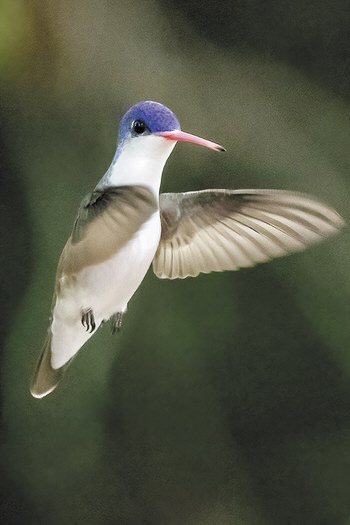
Violet-crowned Hummingbird (photo by Jim Hoagland)
Jim Hoagland
Tucson Audubon’s Paton Center for Hummingbirds is aptly named, with 16 different species of hummingbirds observed in its environment. It was the vision of Wally and Marion Paton, who opened their backyard to the birding community shortly after moving there in 1973. Following their passing, the Tucson Audubon Society, through generous support from the Victor Emanuel Nature Tours and the American Bird Conservancy, built upon the Paton’s legacy by maintaining the backyard birding experience.
Site manager Tom Brown says, to date, 252 bird species have been reported in the 1.4-acre center located on the outskirts of Patagonia. According to Tom, the most desired hummingbird to see is the Violet-crowned Hummingbird. The Paton Center is one of the most reliable locations in the United States to see the Violet-crowned Hummingbird, which can be seen there year-round. Another rare hummingbird sought after when it shows up at the Paton Center is the Plain-capped Starthroat. Since the original first state record of the species in July 1978 near the Paton Center, the Starthroat has been seen only a few times, most recently in July 2023 and September 2020.
Birders from all over the world visit the Paton Center, not just for its diversity of birds, but also for its butterflies, pollinating insects, plants, and mammals. In 2022, the center welcomed 15,000 visitors from 20 countries and all 50 states.
The center is staffed with more than 26 volunteers. On the day that three of the SaddleBrooke Ranch Cuckoos, Karen Vanderwall, Carrie Gelsy, and myself visited, Bob and Lenore Perna were our volunteer hosts. They showed us the many feeding stations as well as the uniquely accessible designed pavilion for watching the feeders. They also pointed out a nesting pair of Thick-billed Kingbirds high in the top of the trees that proved to be lifers for the three of us. Other unique birds to the area are the Mississippi Kite, Gray Hawk, Lazuli, and Painted and Varied Bunting.
According to Tom Brown, the Tucson Audubon recently acquired a 5.0-acre plot between the Paton Center and the Nature Conservancy’s Patagonia-Sonoita Creek Preserve completing a contiguous 2-mile corridor of Sonoita Creek under conservation status. Recently the Tucson Audubon staff has collected more than 500 Fremont cottonwood seedlings that will be planted next to their parent trees along Sonoita Creek to help sustain this important population. Other seedlings will go to their partners in the Pascua Yaqui Tribe to be planted along the Santa Cruz River in an effort to restore some of their most sacred and traditional-use plants.
The Paton Center is open from dawn to dusk year-round and is located on the west end of Patagonia. There is no fee for entry, but your generous donations help them maintain the grounds, feed the birds, and provide educational and recreational programs. It truly is a place to explore and experience the special birds of southeast Arizona.
